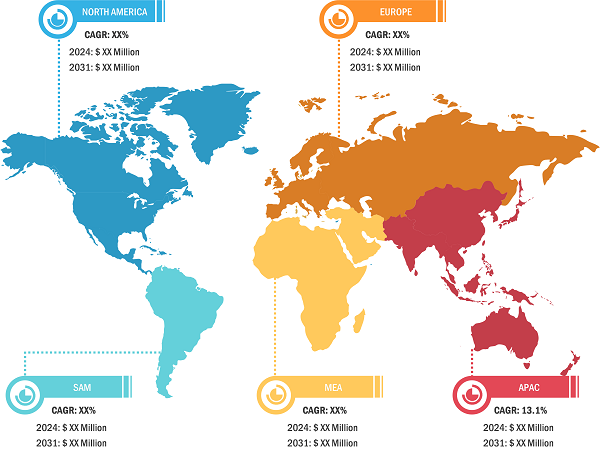Growing Digital Public Infrastructure To Fuel The Digital Forensics Market Growth
According to our latest study, "Digital Forensics Market Size and Forecast (2021–2031), Global and Regional Share, Trend, and Growth Opportunity Analysis – By Component, Type, Industry Vertical, and Geography," the market was valued at US$ 6.03 billion in 2024 and is projected to reach US$ 12.66 billion by 2031; it is expected to register a CAGR of 11.5% during 2025–2031. The report includes growth prospects owing to the current digital forensics market trends and their foreseeable impact during the forecast period.
The rapid expansion of digital public infrastructure comprising data centers, AI hubs, cloud platforms, and advanced connectivity networks is fundamentally reshaping the global digital landscape. This transformation is being driven by the surging demand for data processing, AI computing, and cloud-native operations. On May 15, 2025, Blue Owl Capital Inc. announced the final close of its latest investment vehicle, the Blue Owl Digital Infrastructure Fund III (ODI III), with US$ 7 billion in capital commitments, surpassing its original US$ 4 billion target. ODI III aims to develop and acquire data centers and digital real assets purpose-built to support the world's leading cloud and technology companies. The fund's focus on large-scale, build-to-suit infrastructure reflects the escalating requirements of AI and cloud technologies sectors that generate vast volumes of sensitive and mission-critical data. Similarly, Brookfield Asset Management (BAM), a global leader in infrastructure investment, unveiled a US$ 10 billion AI infrastructure initiative in Sweden on June 4, 2025, with plans to build a state-of-the-art data center in Strängnäs. This facility, set to scale from 300MW to 750MW, will serve as a key AI processing node for Europe. Brookfield's broader commitment over €100 billion (US$ 117.76 billion) in digital infrastructure, renewable power, and semiconductor assets worldwide underscores a global shift toward high-performance, hyper-connected environments. As countries and corporations race to establish digital and AI leadership, the expansion of public digital infrastructure is not only driving innovation but also creating new layers of operational complexity and cyber risk.
Digital Forensics Market Analysis by Geography
Digital Forensics Market Forecast (2021-2031), Global and Regional Share, Trends, and Growth Opportunity Analysis Report Coverage: By Component (Software, Hardware and Services), Type (Mobile Forensics, Computer Forensics, Network Forensics, and Others), Industry Vertical (Government and Defense, Law Enforcement, BFSI, IT and Telecom, Healthcare, Retail, and Others), and Geography
Digital Forensics Market Trends, Size & Growth Analysis 2024-2031
Download Free Sample
Source: The Insight Partners Analysis
This unprecedented digital build-out brings a parallel surge in the need for advanced digital forensics capabilities. As infrastructure grows, so does the potential attack surface, ranging from unauthorized access to critical data centers to breaches in AI processing environments. These high-value digital ecosystems require forensic readiness to detect, investigate, and mitigate security incidents in real time. With billions of dollars being invested in public digital infrastructure, ensuring integrity, availability, and security of these assets becomes mission-critical. Digital forensics plays an increasingly strategic role not only in post-incident analysis but also in supporting compliance, resilience, and governance frameworks across these complex digital environments. As the backbone of modern economies becomes ever more digital, forensic technology is poised to become a foundational layer of infrastructure protection.
Microsoft Corp, International Business Machines Corp, Open Text Corp, Cisco Systems Inc, Cellebrite DI Ltd., Nuix Limited, Magnet Forensics, Paraben Corporation, Exterro, and Oxygen Forensics are among the key players profiled in the digital forensics market report. Other major players were also studied and analyzed in the market study to get a holistic view of the market and its ecosystem.
The report includes the digital forensics market forecast by component, type, and industry vertical. By component, the market is segmented into hardware, software, and services. In terms of revenue, the software segment held the largest digital forensics market share and is expected to register the highest CAGR during the forecast period.
The scope of the digital forensics market report focuses on North America (the US, Canada, and Mexico), Europe (Spain, the UK, Germany, France, Italy, and the Rest of Europe), Asia Pacific (South Korea, China, India, Japan, Australia, and the Rest of Asia Pacific), the Middle East & Africa (South Africa, Saudi Arabia, the UAE, and the Rest of Middle East & Africa), and South & Central America (Brazil, Argentina, and the Rest of South & Central America). North America dominated the market in 2023, followed by Europe and APAC.
The market in Asia Pacific is segmented into Australia, China, Japan, India, South Korea, and the Rest of APAC. In terms of revenue, China held the largest digital forensics market share in APAC. China has witnessed huge growth in the digital forensics market. According to the Center for Strategic & International Studies (CSIS), Chinese reporting claims that in 2024, more than 1,300 cyberattacks attributed to foreign advanced persistent threats (APTs) targeted 14 critical sectors across China. Among the most affected were government agencies, educational and research institutions, the defense industry, and the transportation sector key pillars of national security and economic stability. These attacks were primarily aimed at stealing sensitive data and conducting potential strategic sabotage, reflecting a hostile cyber threat landscape. In light of these developments, the demand for sophisticated digital forensics capabilities in China has grown substantially. Digital forensics solutions are now essential for identifying threat actors, analyzing attack vectors, preserving digital evidence, and supporting both national security investigations and compliance with tightening cybersecurity regulations. As China intensifies its efforts to protect critical infrastructure and safeguard state interests, investment in digital forensics technologies, expertise, and training is surging.
Contact Us
Phone: +1-646-491-9876
Email Id: sales@theinsightpartners.com